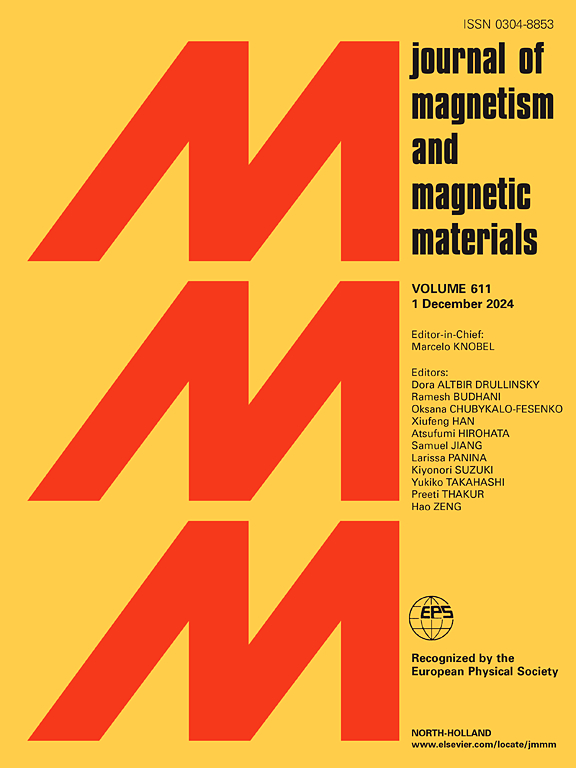正弦磁化分布是产生多用途磁振子晶体的一种原始方法
IF 2.5
3区 材料科学
Q3 MATERIALS SCIENCE, MULTIDISCIPLINARY
引用次数: 0
摘要
在纳米尺度上控制薄膜的磁化强度是实时控制自旋波传播的最佳手段之一。在3D磁控学中,与图案层的垂直或界面相互作用可以使薄膜的磁化偏离均匀性,这通常可以在薄膜中引入新的自旋波模式,从而为信号处理提供额外的自由度。本文提出磁化强度的正弦分布是产生磁振子晶体和控制其磁振子动力学的一种原始而有效的方法。在均匀偏置场的同时,我们在膜层中引入正弦偏置场,模拟与其他层的垂直/界面相互作用:弛豫后,膜的磁化强度呈正弦平衡分布。利用微磁模拟和傅立叶分析,我们展示了如何通过调节磁化波动幅度和对称性来控制磁振子动力学。我们计算了磁振子色散曲线和空间分布,我们展示了信号处理的新自由度的出现以及局域和静止磁振子模式的兴起。我们强调了控制带边界处频率间隙发生和变化的物理机制。最后,我们指出了当垂直耦合是铁电膜和铁磁膜之间的逆磁弹性相互作用时,如何实际实现正弦场(以及随之而来的磁化)。我们的研究结果提出了一种控制磁振子传播的新机制,它对磁振子的动力学具有非常广泛的可调效应,在信号滤波、信息存储和传递以及传感活动的工程中尤其有趣。本文章由计算机程序翻译,如有差异,请以英文原文为准。
A sinusoidal magnetization distribution as an original way to generate a versatile magnonic crystal for magnon propagation
The manipulation of the magnetization in a film at the nanoscale is one of the best means for controlling spin-wave propagation in real time. In 3D Magnonics, the vertical or interfacial interaction with patterned layers can make the film magnetization depart from uniformity, which, in general, can introduce new spin-wave modes in the film, hence additional degrees of freedom for signal manipulation. In this paper, we suggest a sinusoidal distribution for the magnetization as an original and effective way to generate a magnonic crystal and control its magnon dynamics. Along with a uniform bias field, we introduce in the film layer a sinusoidal bias field, simulating the vertical/interfacial interaction with other layers: after relaxation, the film magnetization assumes a sinusoidal equilibrium distribution. Using micromagnetic simulations followed by Fourier analysis, we show how to control the magnon dynamics by tuning the magnetization undulation amplitude and symmetry. We compute the magnon dispersion curves and space profiles, we show the occurrence of new degrees of freedom for signal manipulation and the rise of localized and stationary magnon modes. We highlight the physical mechanisms governing the occurrence and variation of the frequency-gap at zone-boundary. Finally, we indicate how to practically implement a sinusoidal field (and consequent magnetization) when the vertical coupling is the inverse magnetoelastic interaction between ferroelectric and ferromagnetic films. Our results suggest a new mechanism for controlling magnon propagation, which appears extremely appealing for its really wide range of tunable effects on their dynamics, particularly interesting in the engineering of signal filtering, information storage and delivery, and sensing activity.
求助全文
通过发布文献求助,成功后即可免费获取论文全文。
去求助
来源期刊

Journal of Magnetism and Magnetic Materials
物理-材料科学:综合
CiteScore
5.30
自引率
11.10%
发文量
1149
审稿时长
59 days
期刊介绍:
The Journal of Magnetism and Magnetic Materials provides an important forum for the disclosure and discussion of original contributions covering the whole spectrum of topics, from basic magnetism to the technology and applications of magnetic materials. The journal encourages greater interaction between the basic and applied sub-disciplines of magnetism with comprehensive review articles, in addition to full-length contributions. In addition, other categories of contributions are welcome, including Critical Focused issues, Current Perspectives and Outreach to the General Public.
Main Categories:
Full-length articles:
Technically original research documents that report results of value to the communities that comprise the journal audience. The link between chemical, structural and microstructural properties on the one hand and magnetic properties on the other hand are encouraged.
In addition to general topics covering all areas of magnetism and magnetic materials, the full-length articles also include three sub-sections, focusing on Nanomagnetism, Spintronics and Applications.
The sub-section on Nanomagnetism contains articles on magnetic nanoparticles, nanowires, thin films, 2D materials and other nanoscale magnetic materials and their applications.
The sub-section on Spintronics contains articles on magnetoresistance, magnetoimpedance, magneto-optical phenomena, Micro-Electro-Mechanical Systems (MEMS), and other topics related to spin current control and magneto-transport phenomena. The sub-section on Applications display papers that focus on applications of magnetic materials. The applications need to show a connection to magnetism.
Review articles:
Review articles organize, clarify, and summarize existing major works in the areas covered by the Journal and provide comprehensive citations to the full spectrum of relevant literature.
 求助内容:
求助内容: 应助结果提醒方式:
应助结果提醒方式:


